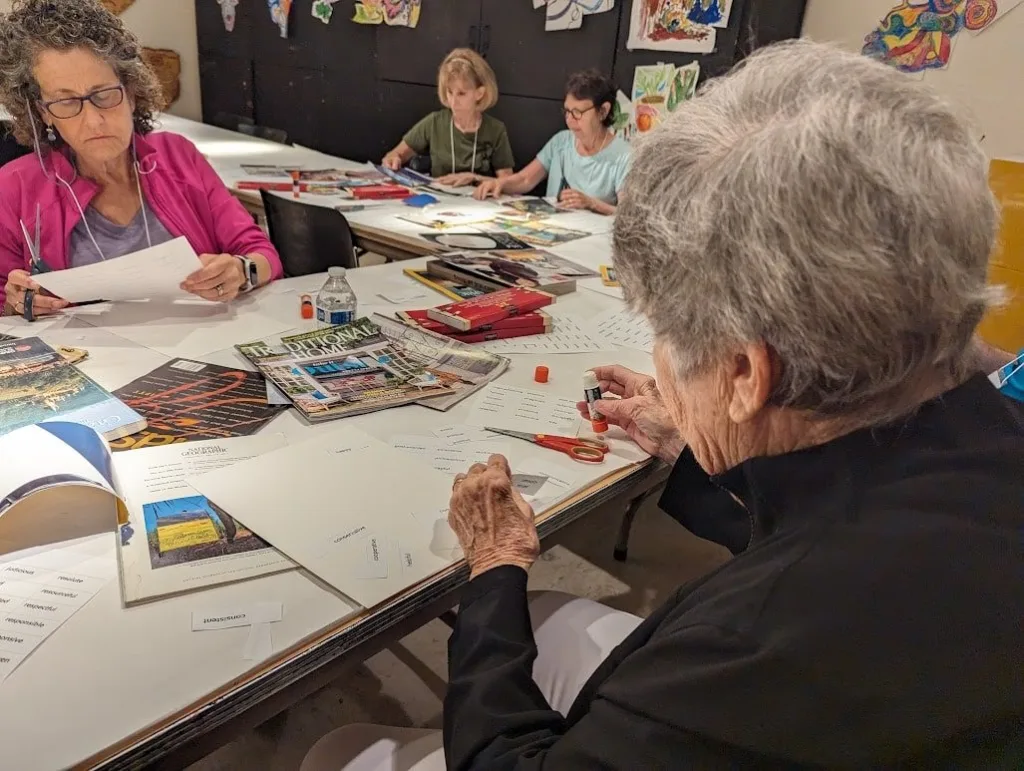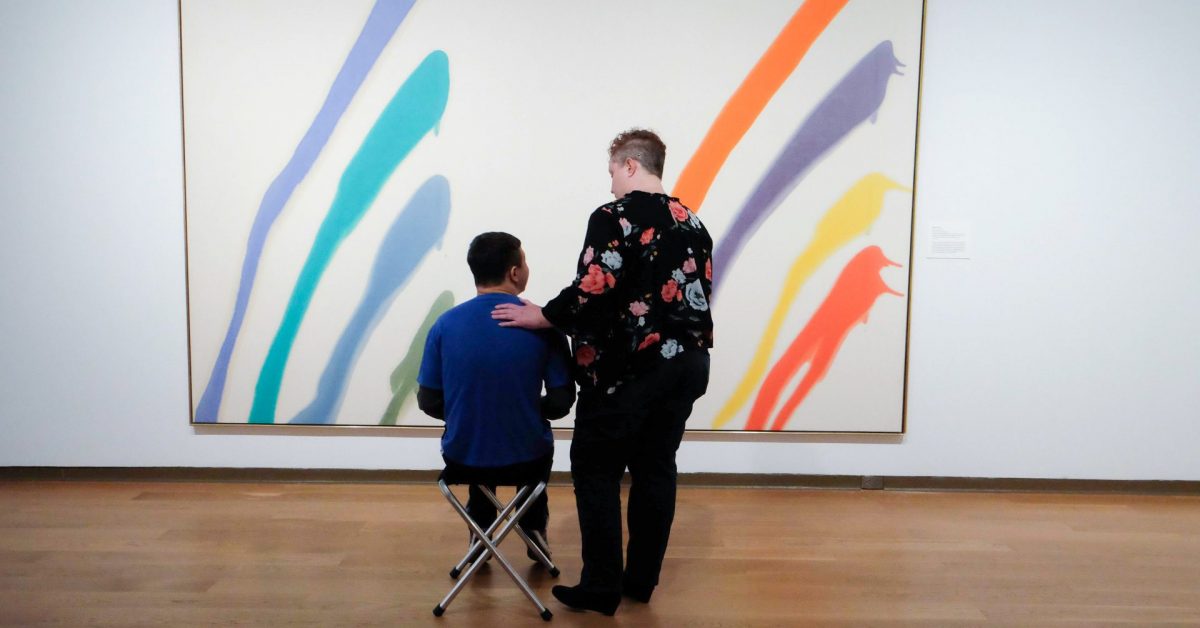
Art is for all. The Orlando Museum of Art (OMA) is equipped with something for all ages and abilities to observe, engage, learn, create, and connect. Through OMA’s Community Access Programs, adaptive education, partnerships, and enhancements, we pursue a welcoming art access experience that is suitable, respectful, and celebratory for all.
Whether you’re a Central Floridian, an out-of-town weekend guest to Orlando, a teacher, student, parent, caretaker, or simply an art enthusiast, your time at OMA should be effortless, effective, and completely inclusive.
What Does Accessible Art Mean?
Accessible art involves removing physical, sensory, and social barriers to increase access to the museum experience. It’s more than just ramps, captions and lighting—although that helps.
Making art accessible is about creating programs that honor alternate ways to view and experience the world:
- Tactile opportunities for those who need touch
- Descriptive language for those who seek or need rich verbal context
- Quiet and slowed experiences for those who operate better with lower sensory input
- Friendly communication and clarification for all
- Multiple entry points to engage with creativity in comfortable ways
At OMA, we make it possible for anyone to experience and interact with what we do. Exhibits are curated and taught not only for purposeful viewing but also for understanding and creativity. We’ve continually adapted and welcomed feedback so that many others can experience and interact as we continue to grow.

OMA Making Art Accessible Through Community Access Programs
OMA’s Community Access Programs create safe, supportive, welcoming access points to art. Trained educators adjust pace, format, and sensory levels to the needs of each individual group while encouraging conversation, curiosity, and comfort throughout the visit.
Community Access Programs for caregivers and participants include:
- Creative Connections: Designed for both youth and adults with physical or developmental disabilities and those on the autism spectrum.
- Arts the Spark: This program allows people with neurological and physiological impairments to engage with art at their own pace.
- Illume: This program is designed for breast cancer survivors, nurturing community and resilience, and supporting participants on their recovery journey.
- Art with Purpose: In collaboration with Zebra Youth, Art with Purpose uses art as a tool for self-expression and growth among LGBTQ+ youth in a safe educational space.
These programs are core components of OMA’s mission. They do not just allow for access; they create belonging. Families, educators, and organizations tell us that the ability to enjoy learning about art in a safe space fosters confidence, connectedness, and pride.
Therefore, we frequently collaborate with agencies serving seniors, youth programs, and disability advocacy groups focused on the arts to co-create opportunities that meet their needs, ensuring every visit is meaningful and respectful.
Accessible Art Education in Action
In the studios and galleries, accessible art education starts with the learner’s abilities and comfort levels. Educators use multiple modalities, visual, verbal, tactile, and movement-based, to welcome participation. You’ll find:
- Many workshops offer adaptive materials on request (i.e., easy-grip tools/textured papers/contrasting color guides) that support fine motor skills and sensory needs.
- Options for adjusted pacing or open-ended Gallery Talks allow participants to determine how much structure they want.
- Generational opportunities made available from youth art programs to teens, to art programs for adults with content suited to interest and ability.
- Gallery talks in Spanish and French for foreign language speakers
People can also celebrate creativity in dedicated on-site galleries such as the Peggy Crosby Student Gallery and Dr. P. Phillips Foundation Gallery with dynamic displays of art as creative potential for all.
For teachers and caregivers, our staff is happy to talk casually about lesson plans and how to work together before a visit. We can also suggest real and simple changes that help learners feel confident before they arrive.

Why Accessible Art Matters
Accessible art matters because it ensures that everyone can enjoy the creativity, connection, and inspiration that comes from art. When museums reduce the thresholds to entry, people have spaces to reflect on themselves, engage on their own or with others, and feel part of something larger.
A study in the Journal of the American Art Therapy Association shows, and lived experiences confirm, that making art maintains mental wellness while energizing imaginations and creating empathy. For families and caregivers, an inclusive museum also serves as respite, a place to slow down and share discovery while fostering joyful routines together.
For Orlando and Central Florida populations, accessible cultural institutions help strengthen the tapestry of our city. They welcome families with children, older adults, veterans, and neurodivergent visitors with disabilities to participate together. The outcome is a richer, fairer arts community, one that appreciates the inclusive nature of the people who live here.
How OMA is Expanding Accessibility
OMA is always considering how best to enhance access through staff training, additional programming, and improvements to our facility through community collaboration. Our inclusivity mission includes:
- Staff training on access protocol/best practices as well as visitor-centered communication.
- Program implementation with Bloomberg Connects for verbal descriptions and guides, plus tactile enhancements and quiet areas that are embedded into tours and classes.
- Co-creation with the community, including feedback discussions with partner organizations, presenters, caregivers, and participants.
- Explicit expectations about tickets, hours, and what to expect, so planning a visit becomes easy and stress-free.
These improvements are continual and responsive. We listen closely to feedback so we can create pilot programs and expand on what works. Accessibility isn’t a list to check off; it is a practice of hospitality and care.
Reach out to us if you have any questions on accommodation or accessibility as you plan your next visit to OMA.
How You Can Participate
Accessible art thrives within a community experience. You can:
- Attend a Community Access Program event: Join an OMA Community Access Program and explore youth art programs or adult art classes.
- Plan your visit: Review ticket information and entry options for museum admission and explore current exhibitions at your leisure.
- Partner with OMA: Educators, caregivers, and organizations are encouraged to work together on customized visits and outreach.
- Provide feedback: Your experience helps us always improve.
Together, we can cultivate the idea that art is for everyone, not merely as a tagline but as an everyday approach.
If you’re a school, community, or service organization in Central Florida, we want to talk to you! We’d love to connect and understand your community so we can create an experience tailored to your goals that helps us better engage with the services you need.


